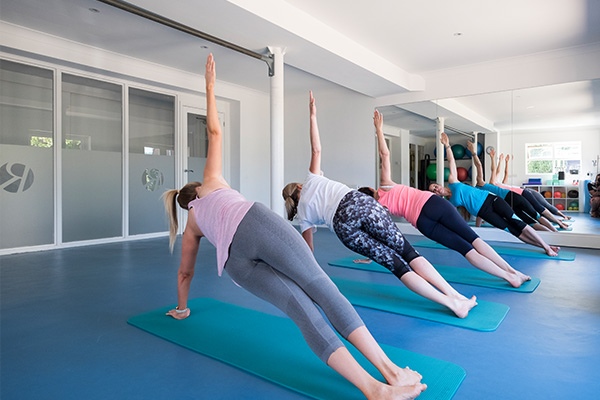Combining Podiatry and Pilates for Better Posture and Athletic Performance
Pilates builds core strength and promotes muscle balance and alignment, all while minimizing joint stress. The combination of these benefits makes it an excellent complement to other physical activities and athletic pursuits.
Even renowned athletes like Tiger Woods use Pilates for their fitness and injury prevention. Unlike some other forms of exercise, Pilates improves a wide range of muscles and joints.

Posture
Pilates emphasizes the development of core muscles to improve balance, flexibility and posture. It strengthens small muscles groups that can help to tone without adding bulk, so it is popular among dancers and other athletes who want to maintain a lean physique. The emphasis on correct alignment can also help to reduce back pain and neck or shoulder injuries.
Pilates teaches students to use the breath and initiate movement from the “powerhouse” of the trunk musculature (the transversus abdominis, oblique, rectus abdominis, and gluteal muscles). This core control can improve balance, increase body awareness, and decrease muscle tension.
As Pilates continues to evolve and gain popularity as a fitness program, research on its effects has increased. One study found that regular Pilates practice increases dynamic balance in healthy elderly adults, compared to those who did not perform the exercises.
Whether you are suffering from low back pain, hip or knee problems, or are looking to enhance your athletic performance, Muscle Joint Bone can integrate Pilates into your treatment plan and assist with injury recovery and prevention. Our experienced Physiotherapists can teach you Pilates techniques and supervise your progress in a fully equipped studio.
Strength
Practicing Pilates with a comprehensively trained professional in a fully equipped studio will help improve the body’s alignment and enhance muscle strength. Incorporating Pilates into a training program will also boost bone density, improve flexibility and increase stability. Clinical pilates Balwyn North improves posture by bringing awareness to the alignment of the spine, and strengthening neglected postural muscles. This improves the ability of these muscles to contract and release — a sign of true strength, enabling them to support and protect the back (6, 7).
Studies have shown that people who are physically active have less chance of developing a spinal deformity such as kyphosis (an exaggerated forward thoracic curvature that results in hunched back) than those who are sedentary (3). Additionally, a recent study found that Pilates-based exercise significantly improved the thoracic curve of healthy women in just 6 months of treatment (4).
When combined with a podiatric diagnosis, and a long-term fitness plan, Pilates can also aid in improving balance and reducing the likelihood of injuries. Injuries often occur as a result of compensatory movement patterns and imbalances. Poor foot positioning and imbalances in the musculature can lead to calluses, corns and overuse injuries. These calluses, corns and overuse can then lead to guarding or compensatory patterns of movement, increasing the risk of injury further along the body’s kinetic chain (8).
Flexibility
Pilates is a low-impact exercise that can be adapted to any fitness level. It incorporates dynamic stretching within the body’s natural range of motion to lengthen muscle fibers and improve flexibility. It also builds strength in the core and pelvic floor muscles, which can help alleviate lower back pain and improve posture.
During a session, clients focus on breath and movement to become more aware of how the body moves as a whole and which muscles are at work. This increased proprioception helps to improve stability and balance and enhances coordination.
For athletes, Pilates can improve the quality of their movements by increasing core strength and improving postural stability. This strengthens the body’s foundation, which can help prevent injury and improve performance during sports or everyday activities.
Pilates can also help reduce stress, as the exercises encourage deep breathing and promote a sense of calm. This is due to the fact that Pilates is an exercise that focuses on controlling the movements and focusing the mind on the body’s alignment and positioning.
Whether you are suffering from lower back pain, want to improve your balance or increase your athletic performance, Pilates is the right choice for you. It can be an ideal complement to your physiotherapy treatment plan, especially if you combine it with a long-term nutrition and wellness program.
Coordination
Pilates is one of the best exercise methods to help improve balance and coordination. This is because it teaches you to engage your core muscles and encourages proper body alignment, which is critical for athletes. This helps you to move with ease and enhances your agility on the field.
In addition, Pilates exercises can lengthen and stretch the muscles, resulting in greater flexibility and range of motion. This is essential for any athlete, as it allows them to move more freely and reduces the risk of injury.
Moreover, the Pilates method has been shown to increase the amount of control you can exert over your body. This is particularly true of the core muscles and the pelvic floor, both of which are important for improving stability and balance.
Additionally, Pilates improves proprioception – the ability to sense and feel your body’s position in space. This enhanced body awareness can make a significant difference to an athlete’s performance, as it improves their ability to anticipate and react to movements.
Whether you are a seasoned athlete or an aspiring dancer, adding Pilates to your exercise routine can dramatically improve your athletic performance. However, if you are experiencing foot, heel or ankle pain or have sustained an injury, it is vital to see a podiatrist Balwyn North before starting any new exercise program.